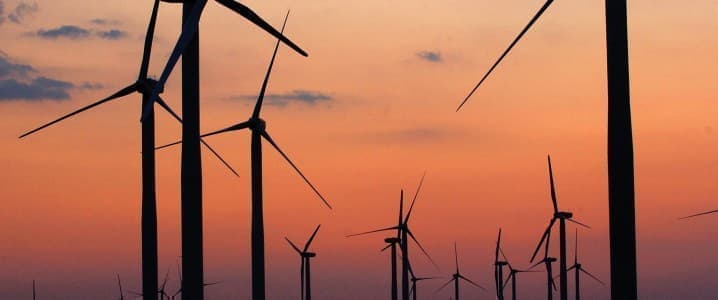Offshore wind has the potential to become a major industry in the United States over the next decade, unlocking billions of U.S. dollars of investment and creating thousands of jobs.
From California’s coast to the Atlantic Coast, the U.S. has the resources to support a large offshore wind industry, but so far, the United States has been lagging behind Europe and Asia in the development of offshore wind. The reasons for slower offshore wind development so far in America are not only the costs of technology. The regulatory and political background has also played a role in the U.S. having just 42 megawatts (MW) of installed offshore wind capacity as of today.
Smoother processes of leasing and permitting of offshore wind projects could facilitate up to US$166 billion in offshore wind investment in the United States by 2035, Wood Mackenzie said in recent research commissioned by the American Wind Energy Association (AWEA), the National Ocean Industries Association (NOIA), the New York Offshore Wind Alliance, and the University of Delaware’s Special Initiative on Offshore Wind.
Offshore Wind Could Generate US$1.2 Billion for the Treasury
According to the consultancy’s base scenario, the U.S. could have as much as 25 gigawatts (GW) of offshore wind built by 2030. If leasing and permitting move faster, the American offshore wind market could develop even faster, according to the study.
WoodMac’s analysis studies the economic impact of offshore wind activities as a result of potential Bureau of Ocean Energy Management (BOEM) lease auctions in the New York Bight, California, the Carolinas, and the Gulf of Maine between 2020 and 2022. BOEM is not expected to hold any lease sales this year, while plans for 2021 are still unclear. But if BOEM moved forward with the leasing, the U.S. Treasury could reap US$1.2 billion in revenue from the lease sales.
The lease sales would mean that offshore wind construction and operation could support around 80,000 jobs per year from 2025 to 2035, and another 16,000 jobs annually after that, the report said. BOEM auctions over the next two years could support the development of 28 GW of offshore wind power, according to WoodMac.
Capital Investment in US Economy Could Reach US$166 Billion
Offshore wind power development could generate a total investment in the U.S. economy of US$17 billion by 2025, US$108 billion by 2030, and US$166 billion by 2035. Related: Locals Donate Hair To Help Soak Up Oil Spill Off Mauritius
Of the US$166 billion investment by 2035, as much as US$107 billion could be generated from the construction industry, another US$42 billion will go to the turbine OEM and supply chain, and US$8 billion will go to transportation industry and ports.
The potential for the U.S. offshore wind industry is enormous, if the right policies are in place, according to sector associations.
Policymakers Hold The Key To Unlocking Billions Of US Dollars
“Policymakers at the Federal and State levels right now hold the key to unlocking the full potential of the offshore wind industry that will benefit all Americans. We’re on the cusp of a rare opportunity, but the U.S. remains far behind other countries in harnessing offshore wind technology,” Laura Morton, AWEA Senior Director of Offshore Wind, said in a statement, commenting on the report.
“American offshore wind is a generational opportunity. Infrastructure spending, energy security, and shovel-ready jobs with good wages will be unleashed,” NOIA President Erik Milito noted.
As the associations and the report they commissioned say, offshore wind is a business of enormous potential in the United States, but it needs policy support, including by accelerating the leasing of areas for new offshore wind power development.
BOEM itself assumes that 22 GW of offshore wind development are reasonably foreseeable along the east coast, the bureau said in June in its Supplement to the Draft Environmental Impact Statement for the proposed 800-MW Vineyard Wind 1 offshore wind project southeast of Martha’s Vineyard off Massachusetts.
Permitting, Policy Could Hamper Offshore Wind Development
The potential for offshore wind growth exists, but the long-term outlook for the sector is not without risks, Wood Mackenzie said in June this year.
Those include permitting delays and political risk at both the state and federal level, which could get in the way of an offshore wind boom, despite state moves to increase mandates and contract large projects, Wood Mackenzie’s principal analyst Max Cohen says. Related: Lithium-Ion Battery Production Set To Quadruple This Decade
“While more than 9 GW of projects are already contracted or soon to be approved, and up to 6 GW more will be solicited through 2022, longer-term uncertainty could see total build this decade reach just 15 GW,” Cohen added.
ADVERTISEMENT
States along the East Coast – Connecticut, Massachusetts, New Jersey, New York, and Virginia – are driving demand for offshore wind, providing certainty for the industry, AWEA said earlier this year.
Several states along the East Coast have pledged and currently support increased share of renewable energy generation.
In June, New Jersey Governor Phil Murphy unveiled plans for the development of the New Jersey Wind Port, the first U.S. infrastructure investment that will provide a location for essential staging, assembly, and manufacturing activities related to offshore wind projects on the East Coast. The plan will cost between US$300-400 million at full build, with the New Jersey Economic Development Authority (NJEDA) leading the development and currently considering a range of public, private, and public-private partnership (P3) financing options.
With supportive policies and smoother leasing and permitting processes, offshore wind development could generate a lot of value for the U.S. economy and create thousands of jobs.
By Tsvetana Paraskova for Oilprice.com
More Top Reads From Oilprice.com:
- A Greener Future Doesn’t Necessarily Mean Giving Up On Oil
- America Could Go Fully Electric Right Now
- The Revolutionary Tech Breathing New Life Into A $600 Billion Industry


















